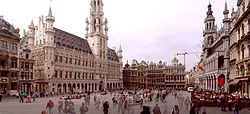Metropolitan areas in Belgium
 From Wikipedia - Reading time: 1 min
From Wikipedia - Reading time: 1 min
National statistics differ between five Metropolitan areas in Belgium.[1] These five metropolitan areas (Dutch: Agglomeratie, French: Agglomération) are also covered by Eurostat statistics as separate Larger Urban Zones (LUZ).
Metropolitan areas
[edit]| Rank | metropolitan area | region | core city population |
metro population |
LUZ population |
LUZ area |
LUZ pop. density |
|---|---|---|---|---|---|---|---|
| 1 | Brussels-Capital Region
|
194,291 (2019) | 1,789,447 (2006) | 1,800,663 (2004)[2] | 1,614 km2 | 1116 inhabitants/km2 | |
| 2 | Antwerp metropolitan area
|
525,935 (2019) | 1,200,000 (2006) | 1,200,000 (2004)[3] | 941 km2 | 972 inhabitants/km2 | |
| 3 | Liège metropolitan area
|
197,327 (2019) | 633,934 (2006) | 626,357 (2004)[4] | 1,055 km2 | 594 inhabitants/km2 | |
| 4 | Ghent metropolitan area |
262,219 (2019) | 416,493 (2006) | 399,741 (2004)[5] | 537 km2 | 744 inhabitants/km2 | |
| 5 | Charleroi metropolitan area
|
202,267 (2019) | 403,868 (2006) | 386,060 (2004)[6] | 615 km2 | 628 inhabitants/km2 |
See also
[edit]References
[edit]- ^ De Belgische Stadsgewesten 2001 Archived 2008-10-29 at the Wayback Machine, Sarah Luyten, Etienne Van Hecke, Instituut voor Sociale en Economische Geografie, K. U.Leuven
- ^ Urbanaudit.org Archived 2008-06-26 at the Wayback Machine
- ^ Urbanaudit.org Archived 2008-06-26 at the Wayback Machine
- ^ Urbanaudit.org Archived 2008-06-26 at the Wayback Machine
- ^ Urbanaudit.org Archived 2008-06-26 at the Wayback Machine
- ^ Urbanaudit.org Archived 2008-06-26 at the Wayback Machine
External links
[edit]Licensed under CC BY-SA 3.0 | Source: https://en.wikipedia.org/wiki/Metropolitan_areas_in_Belgium39 views | Status: cached on August 07 2025 18:44:34↧ Download as ZWI file
 KSF
KSF